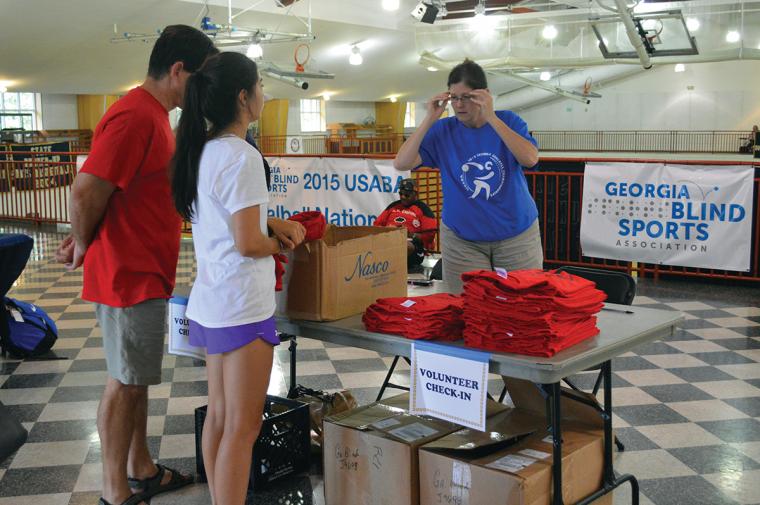

As we in the sports industry know, and in particular, as those of us who are in the non-profit sector are aware, volunteers are the engine that drives our events. You can have great athletes, excellent venues and a crowd ready to watch, but if you don’t have the volunteers who are ready to help out, your event is going to suffer.
At the United States Association of Blind Athletes (USABA), we know this to be absolutely true. In fact, it’s safe to say many of our events couldn’t – and wouldn’t – run without the help of some dedicated volunteers. And we know the secret to having those volunteers is keeping them engaged, invested and happy with the job they’re doing.
In this article, we’ll review some important principles of getting and retaining volunteers – and we’ll show you some real-life examples of what we’ve done to make sure they keep coming back.
First Things First: A Definition
The definition of a volunteer, according to the Oxford English Dictionary, is “one who freely offers to take part in an enterprise or undertake a task.” So to start, you need to differentiate volunteers from your paid staff who are going above and beyond the score of their jobs in order to make the event a success. (Those people are great, but they’re not our focus here.) For the purposes of this article, we will define volunteers as those who are onsite to help you when you’re putting on an out-of-town event.
 Finding the Volunteers
Finding the Volunteers
Finding volunteers in an out-of-town setting can be done several ways. Some events prefer to reach out to CVBs or sports commissions, that may have a list. Some use sports clubs and local organizations where athletes, parents and others might be found who would already have an interest in the sport coming to town. At USABA, we have had great success with people who have indicated a desire to work with blind and visually impaired individuals.
One example for us is the Lions Club, a community service organization that has a long history of working with programs that aid the blind and visually impaired – as well as on preventing blindness. (In fact, their roots in this cause stretch all the way back to when Helen Keller attended the Lions Club 1925 International Convention and challenged members to become “knights of the blind in the crusade against darkness.”)
With a goal like that, the Lions Club was a natural fit for USABA. And for several years now, we have used Lions volunteers to help set up prefabricated goalball courts (goalball being a Paralympic sport for the blind). The kits, which USABA sells, take about 90 minutes to set up. When the Lions come to do it from various clubs in different areas of the country, they are skilled in it and it takes less time. They also enjoy doing a service project that works so well with their mission. In fact, they have a committee for planning and implementing this work.
While not everyone will need to set up courts, the important lesson is this: If you can find volunteers from an organization whose mission is similar to yours, they will find the work of volunteerism both rewarding and relevant.
We’ve also had great success with the Lions Club at national events. Recently, we put on our USABA Goalball Tournament in Fort Wayne, Indiana, and we recruited Lions Club members to help us with running that tournament. When we did a similar event in the Southeastern region of the U.S. with the Georgia Blind Athletes Association, that group also partnered with their local Lions Club.
You don’t need to have a Lions Club to make your event a success. You simply need to find the people who are interested in volunteering and in helping out. You may be able to reach people through Kiwanis Clubs and other service groups, through Boys and Girls Clubs, and through local sports clubs that relate to the tournament you’re bringing to town.
 Getting Volunteers Invested in the Event
Getting Volunteers Invested in the Event
There is a difference between having someone show up to help out with an event and having someone show up, take part and enjoy themselves, and it’s called training the volunteers. If you put in the time to teach your volunteers how to do what needs to be done, they’ll be glad to pitch in. Otherwise, they’re standing around, bored.
Real-life example: One year, our office staff was interested in doing a volunteer project as a group. We wanted to do something completely unrelated to our organization. We identified a community group that was doing some work in our area and contacted them. On the scheduled day, we showed up, ready to give back. Unfortunately, nobody really welcomed us and everyone seemed to be very busy – too busy, in fact to spend time teaching us what needed to be done. We felt uninvolved all day. Several years later, we tried again and this time, we had a really positive experience because the people onsite were glad to see us and willing to put in the time to show us what needed to be done. It was a win/win that day.
There’s no question that everyone is busy at a sporting event – especially the staff. But if you set aside half a day, or a few hours at the least, to let people know what you need, and to assign people to tasks and make sure they’re comfortable with them, they’re likely to feel you’re glad for their involvement and grateful they’re present. They’ll also be happier to help out, and you’ll be happier with the end result – which is an event that runs well.
With our one negative experience under our belts, we have made it a point to make sure our volunteers are well trained and comfortable with the tasks we need them to do. This year, we had nine volunteers show up from the Hope Serving Foundation of the Delta Gamma women’s fraternity to help us out with a three-day goalball tournament and we made sure to walk them through all the things that would happen and all the help we would need.
Right from the start, they were enthusiastic and willing to learn. In fact, not only did they learn what we needed, but they familiarized themselves with the rules of the game, and even put on eyeshades and played it themselves so that they would have the same experience as the athletes. We could not have asked for better participation – and we look forward to working with them again. We know that this current group will age out of college, but when they do, another group will be waiting.
We have learned the power of utilizing volunteers. Many times, sporting event organizers have the thought, “it’s easier if I just do this myself,” but once you get volunteers involved, you understand that it frees up your time. Plus, many people who are volunteers will want to stay involved with the organization’s mission in the long term. They may wind up being donors and promoting your brand – and that has a lasting benefit. All volunteers are necessary to driving the mission of an organization.
Finding the Right Tasks
In any sports organization, there are going to be a number of jobs that need doing by volunteers, and the secret is finding the right person for the right job. That sounds like common sense, but a lot of people overlook it.
In our tournaments, we may need volunteers to perform tasks as varied as:
• Driving athletes to and from events (because transportation is an issue for the blind and visually impaired)
• Shagging balls to people so they can practice catching them (if it frees up a coach or trainer, that person can concentrate on working with the athletes rather than chasing down balls and feeding them in)
• Directing people where they need to go at the entrance to the event
• Answering questions at the registration desk and handing out information
Those are just a few of the tasks, and every sports event will have plenty of others: directing people where to park, handing out T-shirts or information on the city, manning a water stop for a 5K, selling concessions, etc.
Sometimes, volunteers take on incredibly specialized activities. One example is the people who act as our goalball referees. Every one of our referees has been trained extensively in officiating the sport and they donate their time (sometimes 13 hours a day) to us free of charge. All we do is pay their way to tournaments and cover lodging so they can do their jobs.
In addition, each year, we have people who are guide runners who are tethered to a blind or visually impaired athlete during a race, such as a marathon, 5K or 10K race. (Obviously, this is something not everyone can do, but those who can find it very rewarding.) We have people who pilot tandem bicycles, allowing blind and visually impaired racers to compete. We have people whose job it is to stay near the end of the swim lane and tap on the pool deck as a blind swimmer approaches so they know they are getting near the wall. And they are all volunteers. They love working with adaptive sports and blind athletes.
Volunteer Turnover
As was the case with the Delta Gamma women, it’s natural for there to be some turnover among volunteers. You have to expect that. College students will graduate, people will change jobs and not have the same schedule or their interests will change. And realistically, nobody can do the same thing forever. Keep recruiting volunteers for events continually so you’re not caught short-handed.
Giving Back
Yes, we’ve already said that the hallmark of a volunteer is they do something without pay, and that is still true. But providing your volunteers with a token of your appreciation for all the work they have done is going to go a long way. If you can offer a backpack, tote bag, T-shirt and/or lunch, you should since it’s the little perks that keep your volunteers engaged and happy. It may also make a difference between them not simply returning, but bringing a friend or family member to help out next time because they had such a positive experience they want to share it.
Volunteerism in Today’s World
Despite all we’ve heard that might make us pessimistic, volunteerism is increasing – at least from my perspective. Even though people are working longer hours and have hectic schedules, something hasn’t changed: their desire to do good in the world.
If you think about our demographics, you will realize that the Baby Boomer generation is starting to retire – or at least thinking about it – and they are looking for something to do. In fact, that’s one of the reasons we say we have so much success with the Lions Club: a lot of the members have retired and they don’t want to sit around the house. (Their spouses don’t want them sitting around either, but that’s another story.)
People want to be connected, and they need to feel wanted and needed. Working as a volunteer is one of the best ways to do that, and the good news is there are so many ways you can. It’s not too hard to find something that matches your interests. (I’m already thinking about ways to give back once I retire.) SDM

